Accepted Scientific Name: Myrtillocactus geometrizans (Mart.) Console
Boll. Reale Orto Bot. Palermo 1897, 10.
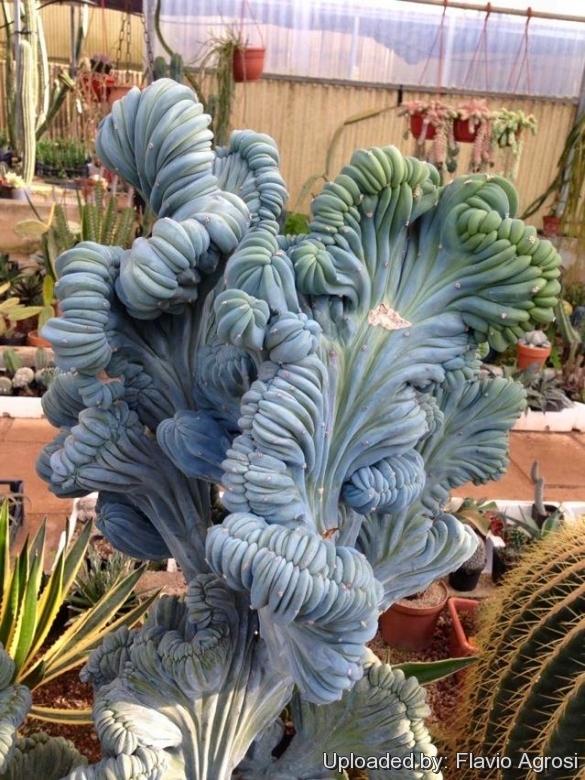
Myrtillocactus geometrizans f. cristatus Photo by: Flavio Agrosi
Origin and Habitat: Garden origin (Nursery produced cultivar). The original natural habitat of this species is northern central Mexico down to Oaxaca.
Synonyms:
See all synonyms of Myrtillocactus geometrizans
back
Accepted name in llifle Database:Myrtillocactus geometrizans (Mart.) ConsoleBoll. Reale Orto Bot. Palermo 1897, 10.Synonymy: 12
Cultivars
(1):
back
Common Names include:
ENGLISH: Crested Blue Flame, Crested Blue Candle, Dinosaur Back Plant, Crested Blue Myrtle
Description: The standard Myrtillocactus geometrizansSN|8050]]SN|8050]] is a highly branched columnar candelabra like tree cactus that creates a dense growth of stems growing closely together. In nature grows up to 4.5 m tall, with the crown reaching up to 5 m in width.
Stems: Glaucous (blue grey) Up to 7-10 cm thick. They have 5-8 ribs that are approximately 2.5 cm in depth with areoles about 2.5 cm apart.
Spines: Each areole may have up to 5-9 spines, but generally they have 3-5 spines about 5-12 mm long. Some spines but not awful.
Flowers: Rather smaller (2.5-3.7 cm) in relation to stem, greenish white.
Blooming season: March. Starts blooming when it is about 60 cm tall.
Fruit: Very sweet, edible, dark red, oblong fruits 8-20 mm in diameter.
Remarks: There are several crested clones of Myrtillocactus geometrizansSN|8050]]SN|8050]] that have a tendency to fan out, some will form stable crests while others (the more common) just cluster over one another. Regardless, both types make for a spectacular landscape attraction.
Subspecies, varieties, forms and cultivars of plants belonging to the Myrtillocactus geometrizans group
Bibliography: Major references and further lectures
1) Edward Anderson “The Cactus family” Timber Press, Incorporated, 2001
2) James Cullen, Sabina G. Knees, H. Suzanne Cubey "The European Garden Flora Flowering Plants: A Manual for the Identification of Plants Cultivated in Europe, Both Out-of-Doors and Under Glass" Cambridge University Press, 11/Aug/2011
3) David R Hunt; Nigel P Taylor; Graham Charles; International Cactaceae Systematics Group. "The New Cactus Lexicon" dh books, 2006
4) Urs Eggli, Leonard E. Newton: “Etymological Dictionary of Succulent Plant Names” Springer, Berlin/Heidelberg 2010
5) Christopher Brickell “RHS Encyclopedia of Plants and Flowers” Dorling Kindersley Ltd, 01/Sep/2010
6) Willy Cullmann, Erich Götz (Dozent Dr.), Gerhard Gröner “The encyclopedia of cacti” Timber Press, 1987
7) Gerhard Gröner, Erich Götz “Beautiful Cacti: A Basic Grower's Guide” Sterling, 1992
8) Hecht “BLV Handbuch der Kakteen” BLV-Verlagsgesellschaft, 1982
9) E Haustein “Der Kosmos Kakteenfuehrer (the Kosmos Cactus Guide)” Balogh Scientific Books, United States, 01/Dec/1998
10) Sánchez , E., Guadalupe Martínez, J., Hernández, H.M., Gómez-Hinostrosa, C. & Cházaro, M. 2013. Myrtillocactus geometrizans. In: IUCN 2013. "IUCN Red List of Threatened Species." Version 2013.2. <www.iucnredlist.org>. Downloaded on 28 April 2014.
11) Jules Janick, Robert E. Paull "The Encyclopedia of Fruit & Nuts" CABI, 2008
12) Clive Innes "Complete Handbook of Cacti and Succulents" Van Nostrand Reinhold Company, 01/dic/1981
 - (Dinosaur Back Plant) is an interesting waxy blue cactus
that forms a tree-like trunk which has a tendency to fan out clustering over one another. Occasionally, when new branches form out from a crest they may revert to the normal growth pattern, giving rise to a more bizarre appearance. Photo by: Valentino Vallicelli
- (Dinosaur Back Plant) is an interesting waxy blue cactus
that forms a tree-like trunk which has a tendency to fan out clustering over one another. Occasionally, when new branches form out from a crest they may revert to the normal growth pattern, giving rise to a more bizarre appearance. Photo by: Valentino Vallicelli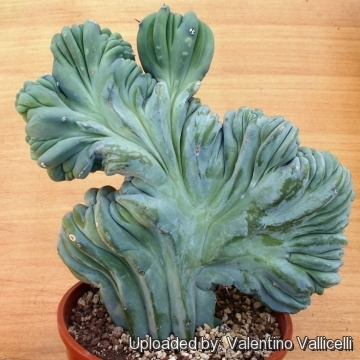 Myrtillocactus geometrizans f. cristatus Photo by: Valentino Vallicelli
Myrtillocactus geometrizans f. cristatus Photo by: Valentino Vallicelli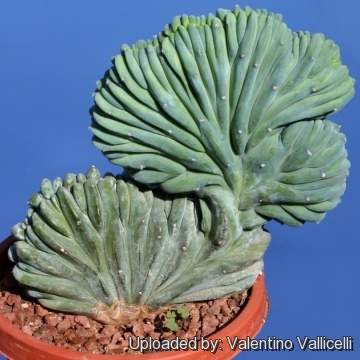 Myrtillocactus geometrizans f. cristatus Photo by: Valentino Vallicelli
Myrtillocactus geometrizans f. cristatus Photo by: Valentino Vallicelli Myrtillocactus geometrizans f. cristatus Photo by: Valentino Vallicelli
Myrtillocactus geometrizans f. cristatus Photo by: Valentino Vallicelli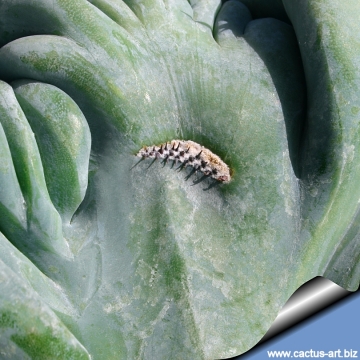 Myrtillocactus geometrizans f. cristatus Photo by: Cactus Art
Myrtillocactus geometrizans f. cristatus Photo by: Cactus Art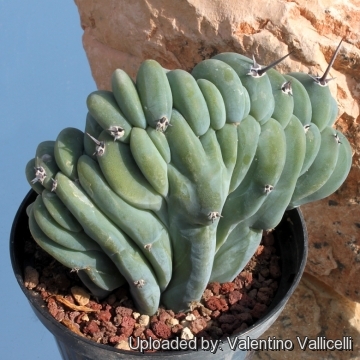 Myrtillocactus geometrizans f. cristatus Photo by: Valentino Vallicelli
Myrtillocactus geometrizans f. cristatus Photo by: Valentino Vallicelli Myrtillocactus geometrizans f. cristatus Photo by: Cactus Art
Myrtillocactus geometrizans f. cristatus Photo by: Cactus Art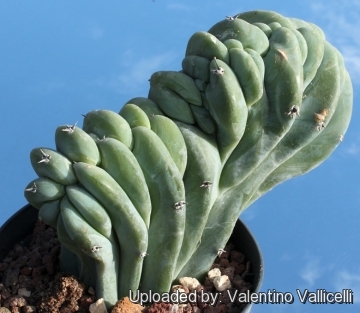 Myrtillocactus geometrizans f. cristatus Photo by: Valentino Vallicelli
Myrtillocactus geometrizans f. cristatus Photo by: Valentino VallicelliCultivation and Propagation: The crests are frequently grafted onto a normal a Myrtillocactus trunk but are easily grown on their own roots. Any normal shoots should be removed to promote the growth of the crest. This cactus tolerates exposure to full sun and generally welcomes moderate watering.They are semi hardy. Make sure that your Myrtillocacti are not exposed to temperatures below -0°C, or they may die. Nevertheless it is good advice never let the night-time temperature fall below 10°C. Water regularly in summer, but allow to dry fully before watering again. It needs a well-drained soil mix, with small gravel added to ensure drainage. During the winter months plants should be rather kept dry, and water is restricted to only enough to keep the stems and branches from shrivelling. Since they are big-sized plants need plenty of space for their roots, repotting should be done every other year, or when the plant has outgrown its pot. Exposure: Light shade when young, full sun later.
Propagation: Cuttings in summer (Cuttings will root only in hot weather. Cuttings must be kept very dry to root).
Your Photos
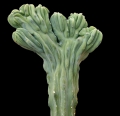
by Valentino Vallicelli
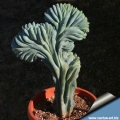
by Cactus Art




















